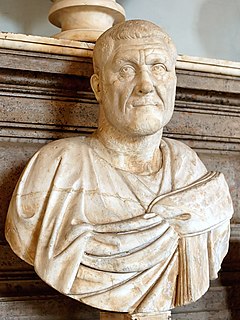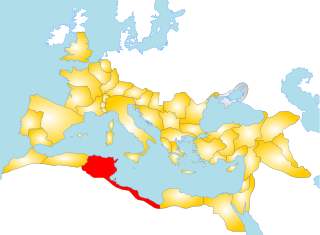Related Research Articles

Marcus Aurelius Severus Alexander was Roman emperor from 222 to 235, and the last from the Severan dynasty.
The 230s decade ran from January 1, 230, to December 31, 239.

Numidia was the ancient kingdom of the Numidians located in northwest Africa, across parts of what is now Algeria, Tunisia and Libya. The polity was originally divided between the Massylii in the east and the Masaesyli in the west. During the Second Punic War, Masinissa, king of the Massylii, defeated Syphax of the Masaesyli to unify Numidia into one kingdom. The kingdom began as a sovereign state and later alternated between being a Roman province and a Roman client state.

Gordian III was Roman emperor from AD 238 to 244. At the age of 13 years and 190 days, he became the youngest sole Roman emperor. Gordian was the son of Antonia Gordiana and Junius Balbus who died before 238. Antonia Gordiana was the daughter of Emperor Gordian I and younger sister of Emperor Gordian II. Very little is known of his early life before his acclamation. Gordian had assumed the name of his maternal grandfather in 238 AD.

Gordian I was Roman Emperor for 21 days with his son Gordian II in 238, the Year of the Six Emperors. Caught up in a rebellion against the Emperor Maximinus Thrax, he was defeated by forces loyal to Maximinus, and he committed suicide after the death of his son.

Gordian II was Roman Emperor for 21 days with his father Gordian I in 238, the Year of the Six Emperors. Seeking to overthrow Emperor Maximinus Thrax, he died in battle outside Carthage. Since he died before his father, Gordian II had the shortest reign of any Roman Emperor in the whole of the Empire's history, at 21 days.

Balbinus was Roman emperor with Pupienus for three months in 238, the Year of the Six Emperors.

Pupienus was Roman emperor with Balbinus for three months in 238, during the Year of the Six Emperors. The sources for this period are scant, and thus knowledge of the emperor is limited. In most contemporary texts Pupienus is referred to by his cognomen "Maximus" rather than by his second nomen Pupienus.
Marcus Asinius Sabinianus was proconsul of the Roman province of Africa. In 240 he led a revolt against Gordian III. He proclaimed himself emperor, but after being defeated by the governor of Mauretania, his supporters in Carthage surrendered him to the imperial authorities.
Herodian or Herodianus of Syria, sometimes referred to as "Herodian of Antioch", was a minor Roman civil servant who wrote a colourful history in Greek titled History of the Empire from the Death of Marcus in eight books covering the years 180 to 238. His work is not entirely reliable although his relatively unbiased account of Elagabalus is more useful than that of Cassius Dio. He was a Greek who appears to have lived for a considerable period of time in Rome, but possibly without holding any public office. From his extant work, we gather that he was still living at an advanced age during the reign of Gordianus III, who ascended the throne in 238. Beyond this, nothing is known of his life.

Thysdrus was a Carthaginian town and Roman colony near present-day El Djem, Tunisia. Under the Romans, it was the center of olive oil production in the provinces of Africa and Byzacena and was quite prosperous. The surviving amphitheater is a World Heritage Site.

Roman Syria was an early Roman province annexed to the Roman Republic in 64 BC by Pompey in the Third Mithridatic War following the defeat of King of Armenia Tigranes the Great.

The Battle of Carthage was fought in 238 AD between a Roman army loyal to Emperor Maximinus Thrax and the forces of Emperors Gordian I and Gordian II.
The Year of the Six Emperors was the year 238 AD, during which six men were recognized as emperors of Rome.
The praetorian prefecture of Africa was a major administrative division of the Eastern Roman Empire located in the Maghreb. With its seat centered at Carthage, it was established after the reconquest of northwestern Africa from the Vandals in 533–534 AD by the Byzantine Emperor Justinian I. It continued to exist until the late 580s, when it was replaced by the Exarchate of Africa.

Gaius Julius Verus Maximinus "Thrax" or Maximinus I was Roman emperor from 235 to 238.
Solomon was an East Roman (Byzantine) general from northern Mesopotamia, who distinguished himself as a commander in the Vandalic War and the reconquest of North Africa in 533–534. He spent most of the next decade in Africa as its governor general, combining the military post of magister militum with the civil position of praetorian prefect. Solomon successfully confronted the large-scale rebellion of the native Berbers (Mauri), but was forced to flee following an army mutiny in spring of 536. His second tenure in Africa began in 539 and it was marked by victories over the Berbers, which led to the consolidation of the Byzantine position. A few years of prosperity followed, but were cut short by the rekindled Berber revolt and Solomon's defeat and death at the Battle of Cillium in 544.
The Siege of Aquileia is a siege battle that took place in 238 in the town of Aquileia during the Year of the Six Emperors which resulted in the assassination of Maximinus Thrax.

Tenagino Probus was a Roman soldier and procuratorial official whose career reached its peak at the end of the sixth decade of the third century AD. A poverty of primary sources means that nothing is known for certain of his origins or early career. However, in later years he served successively as Praeses (governor) of the province of Numidia and of Egypt,. These were both very senior procuratorial offices, the latter in particular traditionally considered one of the pinnacles of an equestrian career. In these roles he exercised military skills in addition to administrative ones; as Praefectus Aegypti he led military operations outside his province. He died resisting the invasion of Egypt by the forces of Zenobia of Palmyra in the troubled inter-regnum between Emperors Claudius II and Aurelian.

The Gordian dynasty, sometimes known as the Gordianic dynasty, was short-lived, ruling the Roman Empire from 238–244 AD. The dynasty achieved the throne in 238 AD, after Gordian I and his son Gordian II rose up against Emperor Maximinus Thrax and were proclaimed co-emperors by the Roman Senate. Gordian II was killed by the governor of Numidia, Capillianus and Gordian I killed himself shortly after, either 21 or 36 days after he was declared emperor. On 22 April 238, Pupienus and Balbinus, who were not of the Gordian dynasty, were declared co-emperors but the Senate was forced to make Gordian III a third co-emperor on 27 May 238, due to the demands of the Roman people. Maximinus attempted to invade Italy but he was killed by his own soldiers when his army became frustrated. After this, the Praetorian Guard killed Pupienus and Balbinus, leaving Gordian III as the sole emperor. Gordian III ruled until AD 244 when he was either killed after his betrayal by Philip the Arab, killed by Philip the Arab or killed at the Battle of Misiche; with his death, the dynasty was ended and Philip the Arab became emperor.
References
- ↑ Herodian, History of the Roman Empire 7.9